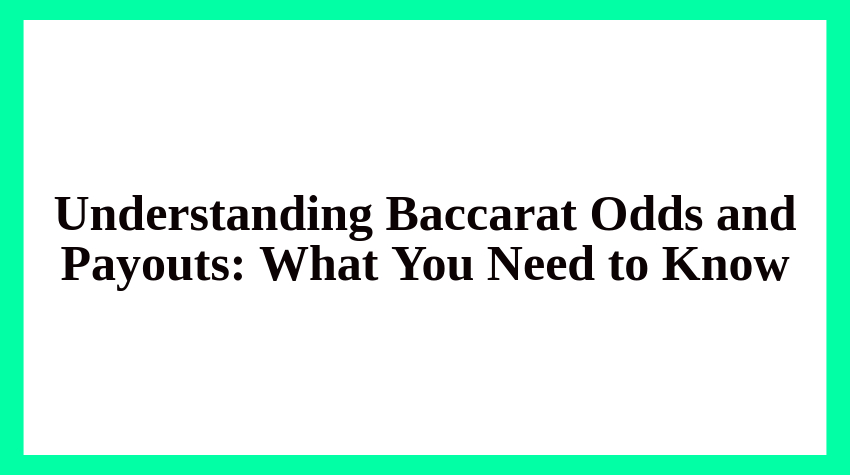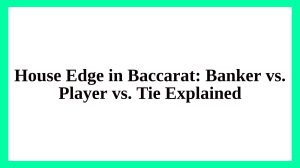Baccarat is a classic casino game known for its elegance and simplicity. With just three main betting options—Banker, Player, and Tie—it offers some of the best Baccarat odds and payouts in the casino world. In this guide, we’ll explore the expected payouts, house edge, and probability of each bet type. You’ll learn when to place which wager and how to calculate potential winnings while keeping the math accessible. If you’re new to the game, start with our introduction to What is Baccarat?
Baccarat Odds and Typical Payout
Banker Bet – The Best Odds
The Banker bet wins about 45.86% of the time and has the lowest house edge in baccarat at around 1.06%. Although the casino charges a 5% commission on wins, this bet still offers the most favorable return for players. A winning bet pays 1:1, but after commission, a ¥1,000 win will give ¥950 in profit and return your original ¥1,000 bet.
Player Bet – Close Behind
The Player bet wins roughly 44.62% of the time, with a slightly higher house edge at 1.24%. It faces no commission but also comes with slightly lower winning odds and payout, making it still a solid secondary option.
Tie Bet – High Risk, High Reward
A Tie bet happens just 9.5% of the time and carries a house edge of roughly 14.36%. While it pays 8:1 (or sometimes 9:1), the extreme rarity of ties makes it a high-risk wager with the worst long-term return.
Side Bets: Higher Payouts, Higher House Edge
Player Pair and Banker Pair
These side bets let you wager that the first two cards dealt to either hand will form a pair. Typical payouts hover around 11:1, but the house edge usually exceeds 10%, making them less advantageous long-term.
Perfect Pair, Big 6, and Other Specialized Bets
Other popular bets like Perfect Pair (pays 25:1) and Big 6 or Dragon 7 offer attractive payouts—but house edges can soar above 13% or even 29%, depending on the variant.
How Payouts Work in Baccarat
Calculating Banker Winnings
- Bet ¥1,000 on Banker
- If you win, the payout is 1:1 (¥1,000) minus 5% commission (¥50)
- Total return: ¥1,950 (¥1,000 bet + ¥950 profit)
Player Winnings Example
- Bet ¥1,000 on Player
- If you win, you receive a full 1:1 payout (¥1,000)
- Total return: ¥2,000 (¥1,000 bet + ¥1,000 profit)
Tie Winnings Example
- Bet ¥1,000 on Tie at standard 8:1
- If the hands tie: Return ¥8,000 plus your original ¥1,000 bet
- Total return: ¥9,000—but remember, you’ll lose most sessions betting the Tie
Probability vs. Return Table
| Bet Type | Probability Won | Payout | House Edge |
| Banker | ~45.86% | 1:1 (minus 5%) | ~1.06% |
| Player | ~44.62% | 1:1 | ~1.24% |
| Tie | ~9.52% | 8:1 | ~14.36% |
| Perfect Pair | ~3.4% | ~25:1 | ~13%+ |
| Other Side Bets | Variable | Varies | 10–30%+ |
Baccarat Variants and Their Impact on Odds
Mini Baccarat and No Commission Versions
In Mini Baccarat, rules mimic classic play but often use fewer decks and lower table limits. Some no-commission variants waive Banker commissions but adjust payouts for certain results like a 6, slightly increasing house edge to around 1.46%.
Chemin de Fer, EZ Baccarat & Side Bet Rules
Variants like EZ Baccarat and Chemin de Fer offer unique side-bet structures and altered rules (e.g., Dragon 7 or Panda 8 bets). For most players, however, sticking to standard Punto Banco rules tends to be the most advantageous due to predictable house edge and payouts.
How to Think About Odds and Strategy
Follow the Banker for the Best Odds
With its lowest house edge, the Banker bet remains the most reliable long-term bet. Even accounting for the 5% commission, it’s statistically the strongest choice.
Switch to Player Occasionally
If you prefer avoiding commission or simply want variety, the Player bet is still reasonable. It often performs similarly over short sessions—but always keep an eye on game streaks.
Avoid the Tie Unless You’re Risk-Tolerant
Tie bets can deliver huge payouts—but expect long stretches without success. As such, they’re best reserved for players who enjoy the thrill, not consistent profit.
Maximizing Your Baccarat Bets Responsibly
Use a Betting System Wisely
Systems like Martingale, 1‑3‑2‑6, or Fibonacci can help structure your play—but they don’t change the house edge. They only control bet size and money management, not probabilities.
Set Win & Loss Limits
Define session limits—e.g., stop when you’ve won ¥3,000 or lost ¥2,000. Baccarat is fast-paced; having preset limits protects your bankroll and keeps your play disciplined.
Take Advantage of Bonuses
Many online casinos reward Baccarat players with deposit bonuses or cashback. Use these promotions responsibly to extend your play—just be mindful of wagering requirements and game restrictions.
For a foundational overview on how baccarat is played—its rules, flow, and variations—check out our full beginner guide: What is Baccarat?
Conclusion: Play Smart with Baccarat Odds and Payouts

\ Bet Smart, Win Big! /
Baccarat offers one of the lowest house edge games found at online casinos. By understanding bet stats—like the 1.06% edge for Banker, 1.24% for Player, and the risky 14.36% for Tie—you can make smart decisions and manage your bankroll effectively.
Side bets and variant formats add excitement but often come with significantly worse odds. Whether you’re a beginner or a seasoned player, knowing the math behind the game can greatly enhance your experience.
For reliable guidance on Baccarat, Blackjack, poker, and other casino games, visit Casino Savvy—your trusted hub for clear, expert casino advice. Visit us at Casino Savvy for more tips, reviews, and strategy guides tailored to online casino enthusiasts in Japan.









Comments